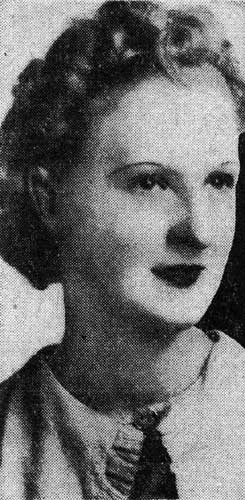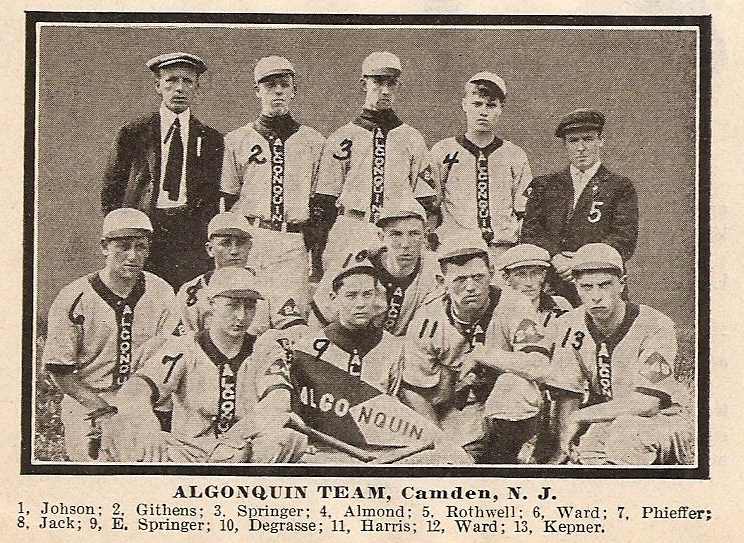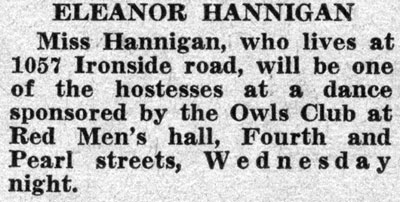ALGONQUIN
TRIBE No. 245
Improved
Order of Red Men - IORM
Westmont, New Jersey
The Algonquin Tribe No. 245 of the Improved Order of Red Men was a fraternal organization active in Haddon Township as early as 1912 and as late as the mid 1930s. A photograph of a baseball team was found in 2014 captioned "ALGONQUIN TEAM, Camden, N.J." where thirteen players and non-uniformed members were identified. Ten appear to be on record as living in Haddon Township in either the 1910 or 1920 Census records, one in a nearby community, the other two, Johnson and Harris, simply have surnames so common that it would be pure speculation as to who they were.
In the case of a couple of the men, an accurate identification is possible. In the case of the others, it is a guess, because these men had brothers of a similar age, and knowing whch brother is which at this point is not possible. Perhaps more information will appear in the future to make an accarate identification possible.
|
1913 Algonquin Tribe Baseball Club |
|
|
The Improved Order of Red Men, a fraternal organization which once was very active in Camden and Camden County, is best remembered in the city of Camden for having built the monument and statue which stood for over 60 years in Pulaski Park, on Haddon Avenue south of Benson Street, the present site of the University of Medicine and Dentistry of New Jersey Camden Campus. The monument, which is topped by a bronze statue of an American Indian Chief, was erected to memorialize South Jersey members of the group who had died while serving with America's armed forces during World War I. Nicola Berardo, a sculptor who lived in Camden, was commissioned to execute project.
In 1981 Pulaski Park was demolished to make way for the University of Medicine and Dentistry of New Jersey Camden Campus. This statue and a statue of General Pulaski were supposedly put in storage, to be re-erected in Camden. This, however, was not the case, as this monument was taken to Route 9 and Center Street in Tuckerton NJ, where it was rededicated on May 21, 1981. The Pulaski Monument was taken to Cooper River Park in Pennsauken NJ.
In 1886 George Reeser Prowell wrote the following account of the Red Men and their female counterparts, the Daughters of the Forest for his book History of Camden County, New Jersey.
The Red Men also owned and operated a hall at As early as 1910 and as late as 1929 at 536 Division Street, the corner of Broadway and Division Street. Beginning in the 1920s and through at least 1928 a building on the southwest corner of North 4th at and Arch was utilized. The Labor Temple at Broadway and Royden was lease for a time in the 1920s. The 1920 and 1930s the Black Hawk Tribe used a hall 715 North 27th Street. These buildings were all known, appropriately enough, as Red Men's Hall, or Halls, to be grammatically correct, By 1929 the Red Men had moved form North 4th and Arch Street to 415 Pearl Street.
The Red Men were very active in Camden for many years. Thomas J. Francis, a member of Lenni Lenape Tribe No. 2, was elected to the Great Council of the United States, the governing body of the red men, in 1866 and was elected to the organization's highest post,Great Incohonee in 1888. Mayor Joseph Nowrey was grand marshal for a parade held in the city in 1904, and of course the monument was placed on Haddon Avenue after World War I.
The 1924 Camden City Directory shows that Camden was the home of the Great Council of New Jersey, at 540 Federal Street, the Daughters of Pocahahontas, and of 10 Tribes, as follows:
| Black Hawk Trine No. 78 | 715 North 27th Street |
| Dakota Tribe No. 111 | 502 Cooper Street |
| Eyota Tribe No. 105 | 573 Division Street |
| Leni Lenape tribe No. 2 | 502 Cooper Street |
| Massasoit Tribe No. 121 | Berkley Hall, 601 Berkley Street |
| Ottawa Tribe No. 15 | Labor Temple, 538 Broadway |
| Pontiac Tribe No. 134 | 502 Cooper Street |
| Saranac Tribe No. 128 (German) | Broadway & Division Street, 536 Division Street |
| Wallawalla Tribe No. 201 | 512 Ferry Avenue |
| Wyoming Tribe No. 15 | 502 Cooper Street |
| Daughters of Pocahontas | 440 Stevens Street |
There was a Saranac Council No. 79 at 440 Stevens Street by 1927 and through 1929. The Ottawa Tribe was still active in 1928, but the 1929 City Directory does not list it. The Directory shows that the Great Council had moved to 7 North 4th Street, and 5 of the Tribes were gone, leaving:
| Black Hawk Tribe No. 78 | 715 North 27th Street |
| Eyota Tribe No. 105 | 575 Division Street |
| Leni Lenape Tribe No. 2 | 7 North 4th Street |
| Saranac Tribe No. 128 (German) | 304 State Street |
| Wyoming Tribe No. 15 | 415 Pearl Street |
| Daughters of Pocahontas | 440 Stevens Street |
The 1947 Directory shows that only the Wyoming Tribe still maintained a building in Camden, at 417 Pearl Street.
Other tribes in Camden County included Standing Elk, Gloucester; Mohican, Haddonfield; Comanche, Atco; Tonawanda, Blackwood; Rancocas, Clementon; Wawa, Berlin; Algonquin, Westmont; Wyandotte, Audubon; and Black Horse, Chews Landing.
|
Camden Courier-Post * January 25, 1928 |
|
CAMDEN COUNTY RED MEN WILL HOLD RALLY HERE Delegations from thirteen Camden county tribes of the Improved Order of Red Men, will attend a rally in the interest of the statewide membership campaign at a meeting of Black Hawk Tribe No. 78, at 715 North Twenty-Seventh Street, tomorrow night. J. Milton Burdge, of this city, past great state sachem, will be the principal speaker. He will speak on “Fraternity.” Tribes which will attend the rally will be Ottawa, Wyoming, Eyota, Saranac, all of Camden; Standing Elk, Gloucester; Mohican, Haddonfield; Comanche, Atco; Tonawanda, Blackwood; Rancocas, Clementon; Wawa, Berlin; Algonquin, Westmont; Wyandotte, Audubon; and Black Horse, Chews Landing. |
| Camden Courier-Post * August 16, 1933 |
|
RED
MEN TO HOLD RlVERVIEW
PICNIC Members of the Improved Order of Red Men Tribes in District 19 of the Reservation of New Jersey will hold an outing at Riverview Beach on Sunday. They will go there by boat, leaving the Chestnut street pier, Philadelphia, at 8.30 a. m. At the beach a varied program of entertainment will be presented, including a ball game between picked players of the Philadelphia and the Camden tribes, as well as swimming races for men and women. It will be an "old-fashioned basket picnic" with other forms of contests for men, women and children. The Wyoming Tribe No. 55, Ottowa Tribe No. 15, Eyota Tribe No. 105, Black Hawk Tribe No. 78. Algonquin Tribe No. 245 and the Councils of the Degree of Pocahontas will participate. Frank C. Englehart is chairman of the outing committee, whose members include Lawrence Cook, Harry Harrold, Edward Altone, Theodore Haines, Harry Rowan, James Coyle, Thomas Symington, William Rothwell and John O'Neil. . |
| Camden Courier-Post * February 28, 1936 |
|
RADICALS ON RELIEF ASSAILED BY VON NIEDA Many of the 116,000 aliens receiving relief in New Jersey are "biting the hand that is feeding them," Mayor frederick von nieda said in addressing the Craftsmen's Protective Association of the New York Shipbuilding Corporation. The mayor addressed more than 1000 craftsmen and their friends at a dance and vaudeville entertainment in Red Men's Hall, Fourth and Pearl streets. Von Nieda charged many of these aliens on relief are radicals and have no place in this country. "When you go over to Communism, either pink or red, I am no longer your friend," von Nieda declared. |
Dance
Hostess
|
Camden Courier-Post February 21, 1938
|
|
|
![]()

